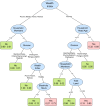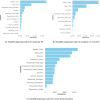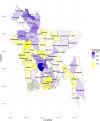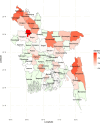Experience-based food insecurity in Bangladesh: Evidence from Household Income and Expenditure Survey 2022
- PMID: 39866494
- PMCID: PMC11761291
- DOI: 10.1016/j.heliyon.2024.e41581
Experience-based food insecurity in Bangladesh: Evidence from Household Income and Expenditure Survey 2022
Abstract
This paper examines the current state of food insecurity in Bangladesh and its socio-economic drivers using data from the latest Household Income and Expenditure Survey (HIES 2022). Unlike previous studies that relied on less precise measures of food insecurity, such as food expenditure, diversity, and calorie intake, this study employs the internationally recognized Food Insecurity Experience Scale (FIES) and Rasch model-based thresholds to classify households as food secure or insecure. Multilevel logistic regression is used to identify significant predictors of moderate and severe food insecurity, considering the hierarchical structure of the data, with households nested within geographical clusters. Key factors found to be significantly associated with food security include the wealth index, land ownership, education of the household head, family size, remittance income and exposure to shocks. A classification tree, a popular machine learning method, is also applied to explore important interactions among these determinants. The tree analysis confirms the importance of several regression-based predictors and identifies households at the highest risk of food insecurity through variable interactions. Factors such as poverty, lack of land ownership, low education levels, and high dependency ratios collectively increase a household's vulnerability to moderate food insecurity to around 51% while the national prevalence is 19%. District-level maps of food insecurity prevalence reveal significant regional disparities, underscoring the need for targeted, district-specific interventions to effectively combat food insecurity. More broadly, policies promoting education and family planning, training in better shock management, and facilitating remittance flows through simplified processes may contribute to addressing the food insecurity challenge.
Keywords: Bangladesh; Classification tree; Food insecurity; Food insecurity experience scale; Multilevel logistic regression; Rasch model; Variable importance.
© 2025 The Author(s).
Conflict of interest statement
The authors declare that they have no known competing financial interests or personal relationships that could have appeared to influence the work reported in this paper.
Figures







Similar articles
-
Predictors and regional prevalence of food insecurity in Ethiopia during COVID-19: a multilevel analysis.BMC Public Health. 2025 Mar 18;25(1):1046. doi: 10.1186/s12889-025-22234-0. BMC Public Health. 2025. PMID: 40102751 Free PMC article.
-
Determinants of the food insecurity at household level in Pakistan: A multilevel model approach.PLoS One. 2023 Oct 5;18(10):e0291343. doi: 10.1371/journal.pone.0291343. eCollection 2023. PLoS One. 2023. PMID: 37797055 Free PMC article.
-
Validity of Food insecurity experience scale (FIES) for use in rural Bangladesh and prevalence and determinants of household food insecurity: An analysis of data from Bangladesh integrated household survey (BIHS) 2018-2019.Heliyon. 2023 Jun 17;9(6):e17378. doi: 10.1016/j.heliyon.2023.e17378. eCollection 2023 Jun. Heliyon. 2023. PMID: 37426788 Free PMC article.
-
Climate shocks' impact on agricultural income and household food security in Bangladesh: An implication of the food insecurity experience scale.Heliyon. 2024 Feb 7;10(4):e25687. doi: 10.1016/j.heliyon.2024.e25687. eCollection 2024 Feb 29. Heliyon. 2024. PMID: 38379971 Free PMC article.
-
The 2023 Latin America report of the Lancet Countdown on health and climate change: the imperative for health-centred climate-resilient development.Lancet Reg Health Am. 2024 Apr 23;33:100746. doi: 10.1016/j.lana.2024.100746. eCollection 2024 May. Lancet Reg Health Am. 2024. PMID: 38800647 Free PMC article. Review.
References
-
- UN, Transforming our world: the 2030 agenda for sustainable development, United Nations: New York, NY, USA, 2015.
-
- FAO, IFAD, UNICEF, WFP, WHO . Food & Agriculture Org; 2023. The State of Food Security and Nutrition in the World 2023: Urbanization, Agrifood Systems Transformation and Healthy Diets Across the Rural–Urban Continuum, vol. 2023.
-
- Avery A. Food insecurity and malnutrition. Komp. Nutr. Diet. 2021;1(2):41–43.
LinkOut - more resources
Full Text Sources

